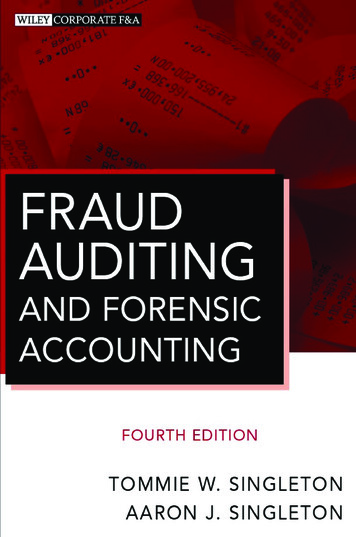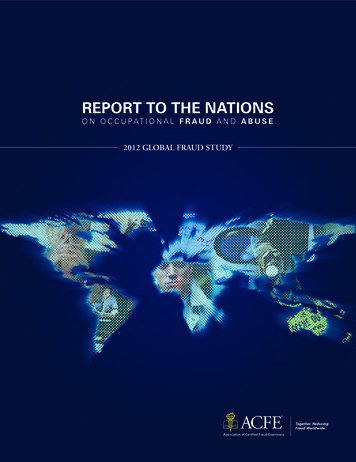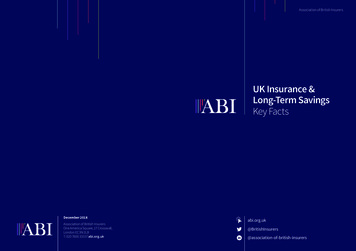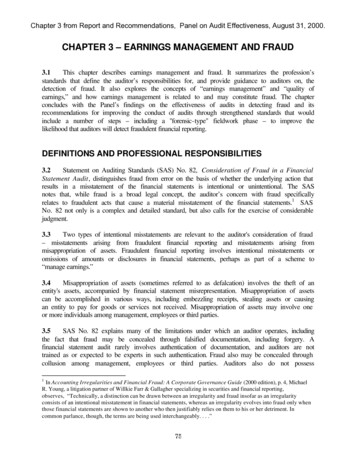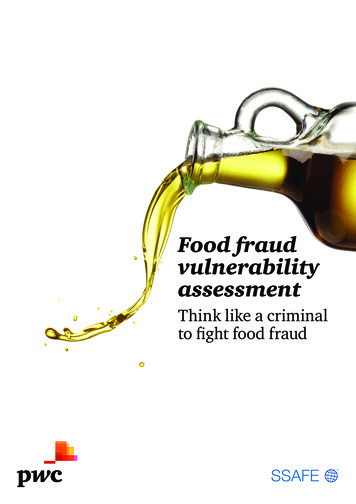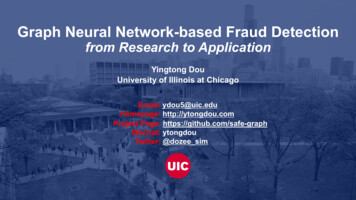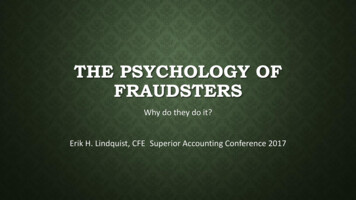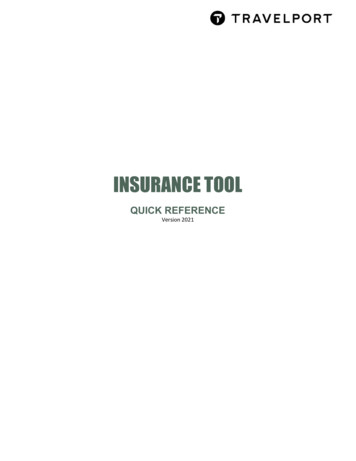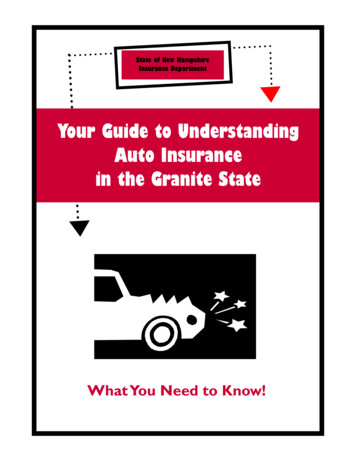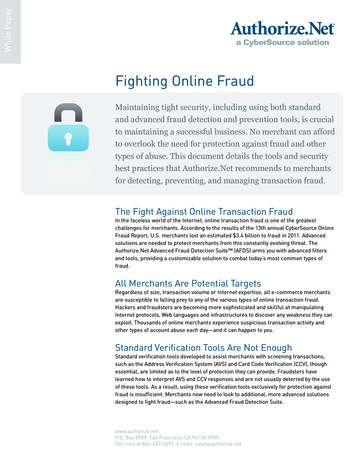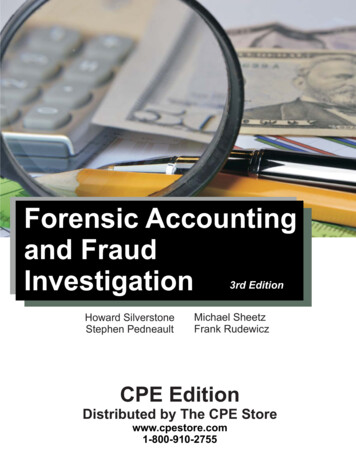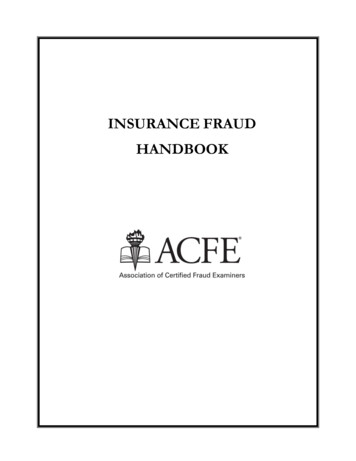
Transcription
INSURANCE FRAUDHANDBOOK
2019 by the Association of Certified Fraud Examiners, Inc.“Association of Certified Fraud Examiners,” “Certified Fraud Examiner,” “CFE,” “ACFE,” “CFEExam Prep Course,” “Fraud Magazine,” “Report to the Nations,” the ACFE Seal, the ACFE Logoand related trademarks, names, and logos are the property of the Association of Certified FraudExaminers, Inc., and are registered and/or used in the U.S. and countries around the world.COURSE REVISION DATE: 12/20/19No portion of this book may be reproduced or transmitted in any form or by any means electronicor mechanical, including photocopying, recording, or by any information storage and retrievalsystem without the written permission of the Association of Certified Fraud Examiners, Inc.The Gregor Building716 West AvenueAustin, Texas 78701 USA(800) 245-3321 1 (512) 478-9000ACFE.comDISCLAIMERS:Every effort has been made to ensure that the contents of this publication are accurate and freefrom error. However, it is possible that errors exist, both typographical and in content. Therefore,the information provided herein should be used only as a guide and not as the only source ofreference.The author, advisors, and publishers caution that this publication is not meant to provide legaladvice. The user should always consult with an attorney regarding the specific rules and regulationsfor your state or locality.Printed in the United States of America.
INSURANCE FRAUD HANDBOOKTABLE OF CONTENTSI. INSURANCE FRAUD OVERVIEWIntroduction to Insurance Fraud . 1Insurance Fraud Schemes . 2Red Flags of Insurance Fraud . 8Summary. 11II. ESTABLISHING AND MEASURING A NEW SPECIAL INVESTIGATION UNITIntroduction . 13Measurement Systems in Place . 15Who Measures? . 15How Often Are Measurements Taken? . 16Calculating Savings . 16Factors in Measuring Performance . 18Additional Rating Factors . 18Expensing SIU Costs . 19Areas of SIU Responsibility . 19SIU Personnel Selection. 20Technology Requirements . 22Data Mining and Link Analysis. 24Integrated Business Processes . 25Anti-Fraud Personnel . 26Summary. 26III. THE POLICY: THE CONTRACTIntroduction . 29Knowing the Policy and Its Language . 31The Policy as a Contract . 32First- and Third-Party Policies . 34Innocent Coinsured . 35Mortgages and Loss Payees . 37IV. CONDUCTING THE EXAMINATION UNDER OATHIntroduction . 41Effective Use of the Examination Under Oath . 44Insurance Fraud Handbooki
INSURANCE FRAUD HANDBOOKIV. CONDUCTING THE EXAMINATION UNDER OATH (CONT.)The Uses of an Examination Under Oath . 46The Interplay of the Arson and Fraud Defenses in a Fire Claim . 51Summary. 54V. THE INSURANCE INTERVIEW PROCESSThe Preliminary Statement of the Insured or Claimant . 57Statement Methods . 59Witness Statements . 66VI. INFORMATION GATHERING AND LEGAL ISSUES OF SHARINGImmunity Reporting Acts . 71Public Records Laws . 76Reciprocal Information Exchange . 78Disclosure . 78Ethics and Insurance Fraud . 82Information Gathering . 82Domain Name Searching. 86Historical Website Information . 86Secretary of State Records . 86City and County Business Licensing . 87Newspaper Searches . 87Professional Licensing . 87UCC Filings . 87Treat All Information Obtained as a Lead . 87Summary. 88VII. CONDUCTING SURVEILLANCEIntroduction . 89Methods of Surveillance. 90Preparation . 90Techniques of Foot Surveillance . 91Techniques of Vehicle Surveillance. 92Fixed Surveillance . 93Satellite Surveillance. 94Night Surveillance Equipment . 94iiInsurance Fraud Handbook
INSURANCE FRAUD HANDBOOKVII. CONDUCTING SURVEILLANCE (CONT.)Vendor Management . 95Summary. 100VIII. EXPERT SELECTION PROCESSIntroduction . 101Selection Process Steps . 101Fire and Explosions . 104From Theory to the Courtroom . 106Spoliation—NFPA 921—Daubert—Systematic Approach. 108Validation of Expert Opinions . 112Scientific Testing: What Can a Laboratory Contribute to the Case? . 114Summary. 115Insurance Fraud Handbookiii
INSURANCE FRAUD HANDBOOKABOUT THE AUTHORJAMES E. WHITAKER, CFE, PCI, CIFIPresidentThe Whitaker Group, LLCJames E. Whitaker is president and founder of the Whitaker Group, LLC, an investigative services andrisk management consultant group headquartered in Ohio. As a retired police detective divisioncommander; FBI National Academy graduate; Special Investigations Unit (SIU) director and later aclaims executive for a property and casualty insurance carrier; and executive director for theInternational Association of Arson Investigators, he has dealt extensively with insurance fraud in itsmany forms since 1971. He has a bachelor’s degree in criminal justice administration and a master’sdegree in management (with an emphasis on organizational design), both attained from MyersUniversity in Cleveland, Ohio.Mr. Whitaker has been a CFE since 1993 and is a Regent Emeritus as well as an adjunct faculty memberfor the ACFE. He has been a guest lecturer at ACFE Annual Conferences as well as ACFE chapters inCincinnati, Columbus, Cleveland, Pittsburgh, Philadelphia, Baltimore, and New Orleans.Mr. Whitaker is a Certified Insurance Fraud Investigator and serves on both the Investigation andInsurance Fraud Councils (co-chair) for ASIS International. He also serves as an adjunct faculty memberfor ASIS on the PCI (Professional Certified Investigator) review course faculty. Mr. Whitaker is afrequent lecturer on the topic of insurance fraud across the United States and serves as a consultant tovarious insurance companies on fraud-related issues, employee training, and ethics programdevelopment.Insurance Fraud Handbookv
Insurance Fraud OverviewI. INSURANCE FRAUD OVERVIEWIntroduction to Insurance FraudAside from tax fraud, insurance fraud is the most practiced fraud in the world. The insurance business,by its very nature, is susceptible to fraud. Insurance is a risk distribution system that requires theaccumulation of liquid assets in the form of reserve funds that are, in turn, available to pay loss claims.Insurance companies generate a large, steady flow of cash through insurance premiums. Steady cashflow is an important economic resource that is attractive and easily diverted. Large accumulations ofliquid assets make insurance companies attractive for take over and loot schemes. Insurance companies areunder great pressure to maximize the return on investing the reserve funds, thus making themvulnerable to high yielding investment schemes.What Is Insurance Fraud?To conquer insurance fraud, one must first know what insurance is. In basic terms, it is a contractbetween an insurer and an insured. In a contract, the insurer indemnifies the insured against losses,damages, or liability from an unknown event. A preexisting condition must not exist for insurance to bevalid. For example, obtaining automobile insurance after an accident is not insurance and does notindemnify the insured for any injuries suffered. Insurance fraud exists when individuals attempt to profitby failing to comply with the terms of the insurance agreement. Perpetrators of insurance fraud try tocreate losses or damage rather than joining others who have no losses but wish to keep themselvesprotected in case an unknown event should occur. Fraud can occur at any stage of an insurancetransaction by any of the following: Individuals applying for insurance Policyholders Third-party claimants Professionals who provide services to claimantsInsurance fraud can come in two forms: (1) hard frauds and (2) soft frauds. A hard fraud occurs whenan accident, injury, or theft is contrived or premeditated to obtain money from insurance companies.When a legitimate loss occurs, such as theft of a cell phone, and the insured adds an item to the claim(e.g., a phone accessory) to cover the deductible, it is considered a soft fraud. Soft fraud occurs when alegitimate claim is exaggerated.Impact of Insurance FraudThe cost of insurance to consumers continues to grow each year due to the huge losses that occurwithin the insurance industry. Most carriers can only estimate what they lose to claims that arediscovered to be fraudulent. Insurance fraud usually does not come to light until the fraudsters getgreedy and it becomes apparent that they are involved in an insurance fraud scheme.Insurance Fraud Handbook1
Insurance Fraud OverviewInsurance fraud is not limited to one group, race, or gender. It is an equal opportunity crime that can beperformed by an insurer or an insured. Insurance fraudsters are less likely to be turned over to theauthorities because they are usually not equipped to handle or perform an adequate investigation due tolack of expertise in insurance. For insurance fraud to be proactively addressed, insurers must train theirstaff in identifying the red flags of insurance fraud schemes.Insurance Fraud SchemesThere are numerous types of insurance fraud schemes. This section introduces some of the mostcommon types of fraud involving the insurance industry: Agent and broker schemes Underwriting irregularities Vehicle insurance schemes Property schemes Life insurance schemes Liability schemes Health insurance schemes Worker’s compensation schemesAgent and Broker FraudCash, Loan, and Dividend ChecksA company employee without the knowledge of an insured or contract holder requests cash, a loan, or adividend check, and deposits the check into either their bank account or a fictitious account. Tominimize their chances of being detected committing a fraudulent act, the employee might change thecompany policyholder’s address of record to either their address or a fictitious address. Once the checkis issued, the address is then changed back to the previous address.Settlement ChecksA company employee can misdirect settlement checks, such as for a matured endowment settlement, tothe branch office, the employee’s home, or a fictitious address. The employee can easily create a checkdefalcation by changing the address of record prior to the settlement check issue date, thus misdirectingthe check in question. Also, an orphan contract holder might be transferred to the employee’s agencyperiodically, affording the opportunity to improperly request the issuance of a settlement check.An orphan contract holder is a policyholder or contract holder who has not been assigned to a servicingagent or the whereabouts of this individual is unknown. The servicing agent attempts to locate thisfamily group and could influence them to purchase additional insurance.2Insurance Fraud Handbook
Insurance Fraud OverviewPremium FraudThe agent collects the premium, but doesn’t remit the check to the insurance company. The insured hasno coverage.Fictitious PayeesAn agent or a clerk can change the beneficiary of record to a fictitious person and subsequently submitthe necessary papers to authorize the issuance of a check.Fictitious Death ClaimsAn agent or employee obtains a fictitious death certificate and requests that a death claim check beissued. The agent receives the check and cashes it.The sales representative can also write a fictitious application and, after the contestable period (e.g., twoyears), submit a phony death claim form and obtain the proceeds. The agent, by investing a fewthousand dollars, could receive 50,000 or more in misappropriated claims.Underwriting IrregularitiesEquity FundingEquity funding is the process of using existing premium/policy values to finance new businesses. Solong as the insured
Cash, Loan, and Dividend Checks A company employee without the knowledge of an insured or contract holder requests cash, a loan, or a dividend check, and deposits the check into either their bank account or a fictitious account. To minimize their chances of being detected c
